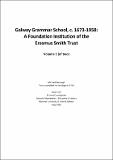| dc.description.abstract | This thesis is concerned with Galway Grammar School, from its opening about 1673 to its closure in 1958. It provides a broader understanding of Protestant grammar school education, particularly as it operated on the periphery of the Protestant community. The School was one of three grammar schools, the others being at Drogheda and Tipperary, which were at the core of the Erasmus Smith Trust, established by royal charter in 1669. The history of the School is entwined with that of the Trust, with its fortunes being impacted by the policies and priorities of its Board. Consequently, a particular perspective on the administration of the Trust over almost three centuries is gained.
The study allows for consideration of the issue of social class as manifested by the manner in which the Board of the Trust, with an elite, and predominately Dublin-based, Anglican membership, and the headmasters of the School, viewed and applied the provisions of the Trust for the education of sons of tenants and of poor children. Some insight is gained into developments over time in the quality of care deemed appropriate for middle-class boys. Meanwhile, a perspective on the interrelationship between the School and the predominately Catholic Galway town is provided.
Galway Grammar School is put in comparative perspective by reference to the other grammar schools of the Trust, to reports on the endowed school sector generally, and to developments in other schools. A local perspective is provided through an overview of the second-level provision available to and availed of by Protestants in Co. Galway, within and outside of the county, during the period under review.
The composition of the pupil body, including the domiciliary origin and socio-economic background of pupils, together with their subsequent education, careers and domicile, is considered by reference to the School Roll Book, 1895-1952, thereby contributing towards an understanding of patterns of geographical, educational and social mobility amongst middle-class Protestants. The participation of former pupils in World War I is discussed, and a profile of pupils identified as participants in the War is included as an appendix. | en_IE |
| dc.local.note | Research has been conducted on Galway Grammar School, c. 1673-1958, a foundation institution of the Erasmus Smith Trust. The history of the School was impacted by the policies and priorities of the Trust’s Board, comprised of leading members of the Anglican community. A particular perspective on the administration of the Trust is, therefore, provided. | en_IE |



